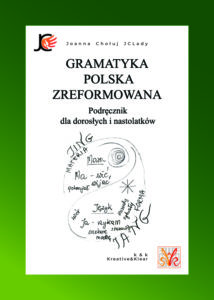BOOK IN POLISH
"Polish Grammar Reformed. Textbook"
This book describes reformed Polish grammar and is a practical textbook for learning the Polish language.
It differs from the book "Polish Ancient Grammar" in that it is a specific, logical and clear lecture on Polish grammar.
It is a new proposal for learning Polish grammar in an orderly and logical way.
This book is less extensive than the two volumes of "Polish Ancient Grammar", it does not explain everything as thoroughly in relation to other classical grammars, Old Church Slavonic, Latin and Sanskrit, and it has only a few sample verb tables, and all the important knowledge is presented in a highly condensed way.
All the necessary Polish conjugation tables can be found in the two volumes of "Polish Ancient Grammar"
Grammar exercises can be found in "Polish Ancient Grammar. Exercises"
Table of contents
And From big to small.
LANGUAGE KNOWLEDGE
1. What is language and what is it for?
2. What is grammar
3. Learning method – spiral and linear
4. The structure of grammar
5. Types of languages
6. Coding – Decoding. Functions of Utterance
7. Where did the Polish language come from?
II From small to large.
PHONETICS VOICE ROOM. GRAPHIC RECORDING
8. Sound matters
9. The sign matters
10. Sounds
11. Alphabet – signs
12. Pronunciation rules
13. Rules of recording
MORPHOLOGY WORD FORMATION
14. Etymology – the origin and meaning of words
15. Root First Verbs
16. Word structure and creation of new words
17. Types of verb
18. Immanent, built-in gender of a noun
19. Noun Number and Double Nouns
MORPHOLOGY – INFLEXATION
20. Parts of Speech. Declinable and Indeclinable
21. Declension of nouns. Cases of declension
22. Double Nouns. Declension
23. Adjective – two types. Declension
24. Pronoun
25. Numeral
26. Three tenses
27. Verb conjugation
28. Three conjugations and two aspects – Multiplicity and Perfection
29. Aspects of the verb: single JK – multiple WK, and perfect DK
30. Aspect of the verb BN passive – CN active
31. Aspect of the verb ZW reflexive – NW non-reflexive
32. Aspect of the verb OB NB
33. The aspect of the verb WP contemporary – UP anterior
34. The aspect of the verb NO is negative (negative) – PO is positive (affirmative)
SYNTAX
35 The Seven Verb Moods
36 Moods: Indicative. Imperative. Interrogative
37 Moods: Conditional and Modal
38 Parts of Speech and Parts of Sentences. Single Sentences
39 Coordinate complex sentences
40 Subordinate clauses
41 Direct and indirect speech

